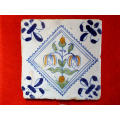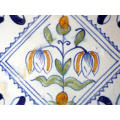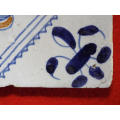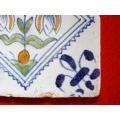View the relisted Item
Similar products
A very rare antique polychrome Dutch Delft Tile circa 1630-1650 Ref. CL-20
Check my rate
| Main centres: | 1-3 business days |
| Regional areas: | 3-4 business days |
| Remote areas: | 3-5 business days |
Product information
Description: A very rare antique polychrome Dutch Delft Tile circa 1630-1650 Ref. CL-20
Maker: Dutch faience polychrome wall tile. Although most tiles are said to be Delft, they were also produced in other towns like Amsterdam, Gouda, Makkum, Middelburg, Utrecht, Harlington etc.
Date: 1630-1650
History: Faience is a French word depicting tin-glazed earthenware. The name Delft comes from the City of Delft which was famous for its blue and white earthenware and slightly later, its Polychrome earthenware(pieces showing different colours). The blue colouring was first used as the colour did not fade when the earthenware was heated in the kilns. These Delft tiles as well as other earthenware goods were very popular and exported widely throughout Europe and Britain. The Netherlands, at this time, was known for its prosperity and tiles were virtually only found in homes of wealth. The serrated rhombic border surrounding the tulip flower was introduced in the 1630s (and, again used in the 1750s) as well as the corner motif showing the modified French Lily design. The pattern on the tile was first drawn on paper and then pricked with tiny holes. This was laid onto the surface of the tile and held in position by small nails. Take note of the three nail holes in the corner motifs. Powdered charcoal was spread on top of the paper, which, when removed, allowed the painter to see a faint outline of the subject to be painted. Note the thickness of the tile, early Dutch tiles were rather thick and heavy.
Condition: For its age, the tile remains in very good condition.
Dimensions: 13 cm x 13 cm x 1.1 cm
Price: R2000.00
Please note, I am NOT a qualified archaeologist/antiquarian and the description I have given is based on research of the subject.
This is a genuine antique. Please remember the classification of an 'antique' is that it should be 100 years old, OR MORE.
Terms: We offer a strict three-day approval period from the date the parcel reaches you. Refunds/credits are based on the cost of the article, NOT including delivery charges. Please advise us within this period whether you would like to return any article for a refund/credit. Although we pride ourselves in our packing, the buyer remains responsible for loss, non-arrival or damage to goods being sent to, or returned.



